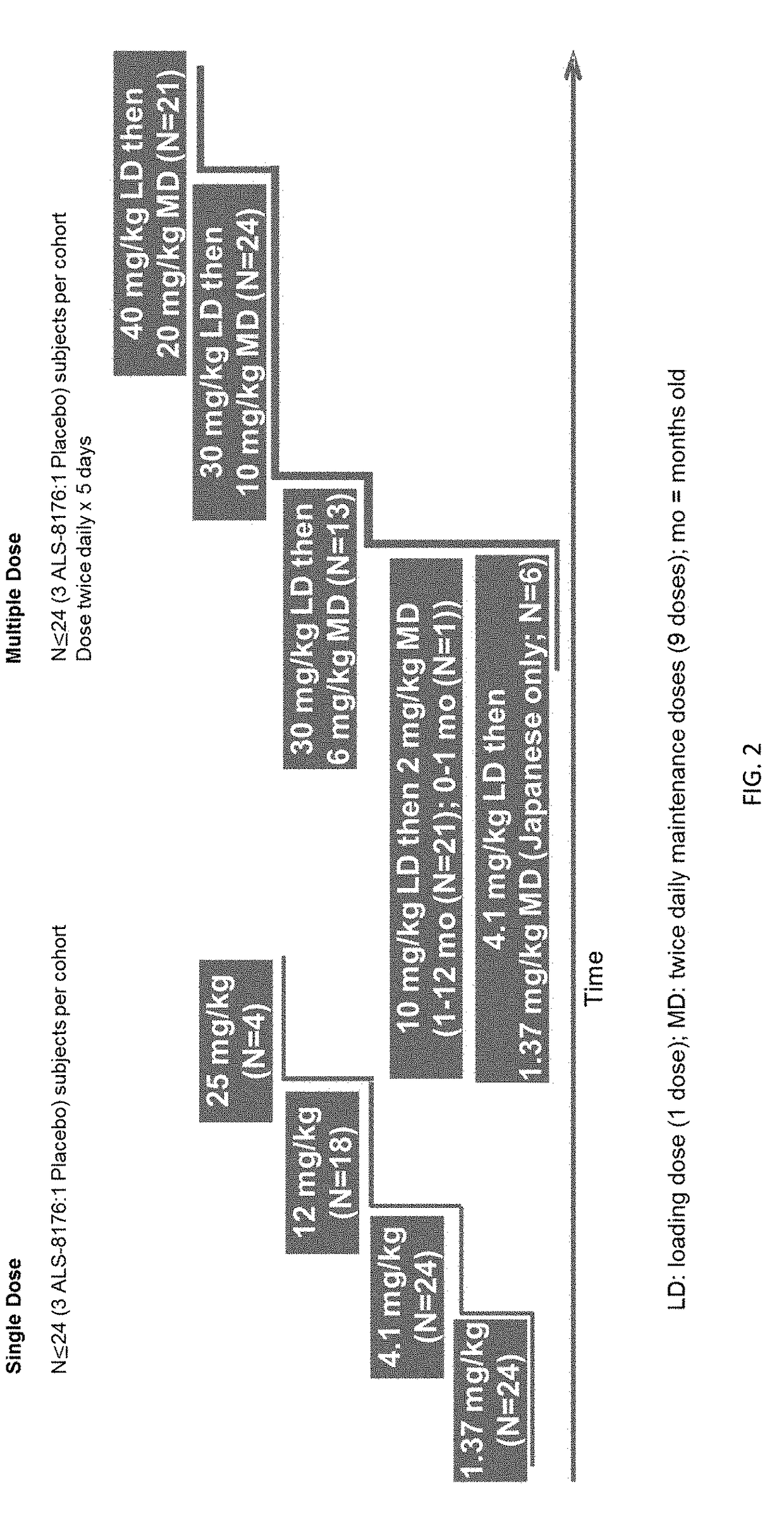Methods for treating respiratory syncytial virus infection
a technology of respiratory syncytial virus and treatment method, which is applied in the field of chemistry, biochemistry and medicine, can solve the problems of low respiratory rate, significant burden of rsv infection in neonates, and no vaccine is currently approved for the prevention of rsv infection
- Summary
- Abstract
- Description
- Claims
- Application Information
AI Technical Summary
Benefits of technology
Problems solved by technology
Method used
Image
Examples
example 1
Treatment Regimens
[0080]Healthy adults received one of the following dosing regimens or placebo over 5 days using the human RSV challenge model.
RegimenFirst DosageSecond Dosages1750 mg (single dosage)150 mgN = 72750 mg (single dosage)500 mgN = 83375 mgN = 84PlaceboN = 12
[0081]Patients were given an intranasal inoculation of RSV-A Memphis 37b challenge virus. Administration of compound (A), or a pharmaceutically acceptable salt thereof, began approximately 12 hours after confirmation of RSV infection as determined by the presence of RSV RNA in nasopharyngeal washes. The test compound was administered as an oral-liquid suspension, wherein the drug vehicle was methyl cellulose and sterile water. The placebo was the drug vehicle without the test compound. Second dosages were started 12 hours after administration of the first dosage, and the remaining second dosages were provided in approximate 12 hour intervals. Nasal washes were collected twice daily approximately 36 to 48 hours after ...
example 2
Treatment Regimens in Adult Patients
[0083]Within the clinical development program, a range of doses and durations are evaluated in adults with a RSV infection using a compound described herein (for example, compound (A), or a pharmaceutically acceptable salt thereof). For example, patients receive one of the following orally administered dosing regimens over 5-7 days in a randomized clinical trial.
Dose Regimen(mg)Dose 1Dose 2Doses 3-10750 / 500 mg750 mg500 mg500 mg (BID)750 / 150 mg750 mg150 mg150 mg (BID)500 / 150 mg500 mg150 mg150 mg (BID)
example 3
Treatment Regimens in Pediatric Patients
[0084]Within the clinical development program, a range of doses and durations are evaluated in infants and children with a RSV infection using a compound described herein (for example, compound (A), or a pharmaceutically acceptable salt thereof). For example, patients receive one of the following orally administered dosing regimens over 5-7 days in a randomized clinical trial.
Dose Regimen(mg / kg)Dose 1Dose 2Doses 3-10 25 / 5 mg / kg25 mg / kg 5 mg / kg 5 mg / kg (BID) 10 / 2 mg / kg10 mg / kg 2 mg / kg 2 mg / kg (BID)50 / 10 mg / kg50 mg / kg10 mg / kg10 mg / kg (BID)40 / 20 mg / kg40 mg / kg20 mg / kg20 mg / kg (BID)60 / 40 mg / kg60 mg / kg40 mg / kg40 mg / kg (BID)
PUM
| Property | Measurement | Unit |
|---|---|---|
| time period | aaaaa | aaaaa |
| time periods | aaaaa | aaaaa |
| time period | aaaaa | aaaaa |
Abstract
Description
Claims
Application Information
 Login to View More
Login to View More - R&D
- Intellectual Property
- Life Sciences
- Materials
- Tech Scout
- Unparalleled Data Quality
- Higher Quality Content
- 60% Fewer Hallucinations
Browse by: Latest US Patents, China's latest patents, Technical Efficacy Thesaurus, Application Domain, Technology Topic, Popular Technical Reports.
© 2025 PatSnap. All rights reserved.Legal|Privacy policy|Modern Slavery Act Transparency Statement|Sitemap|About US| Contact US: help@patsnap.com



